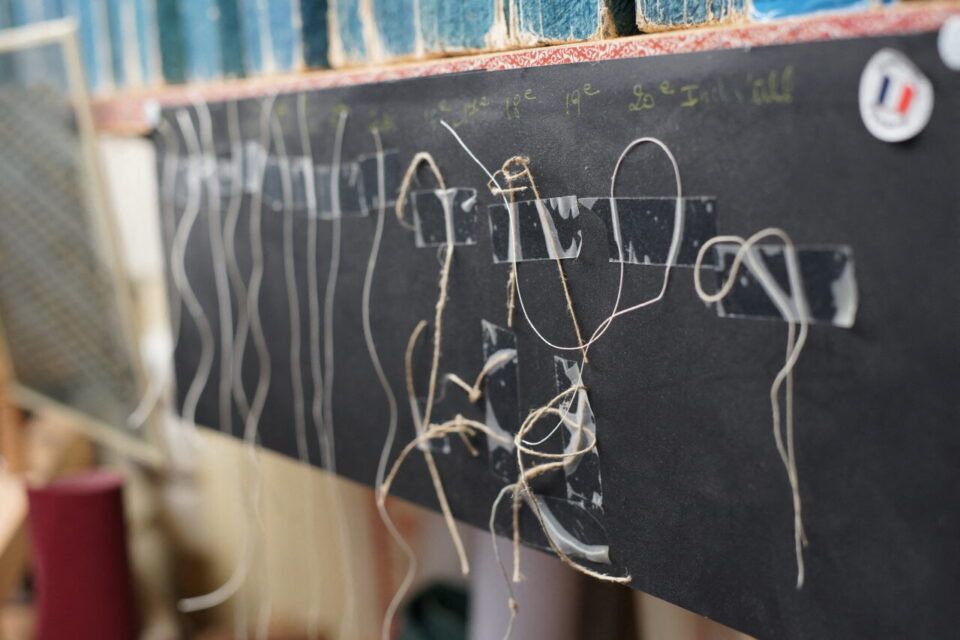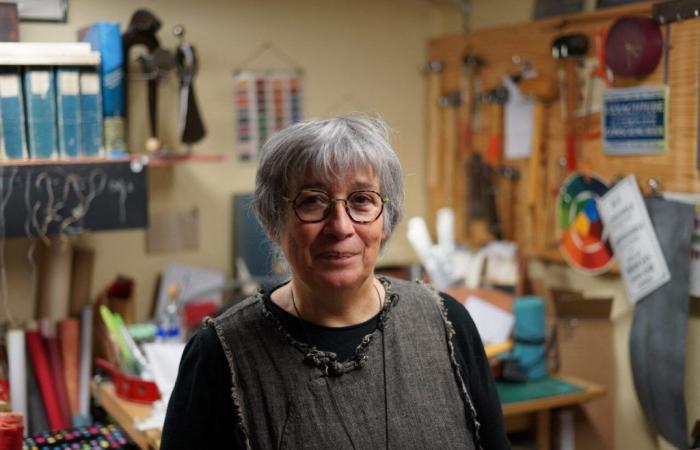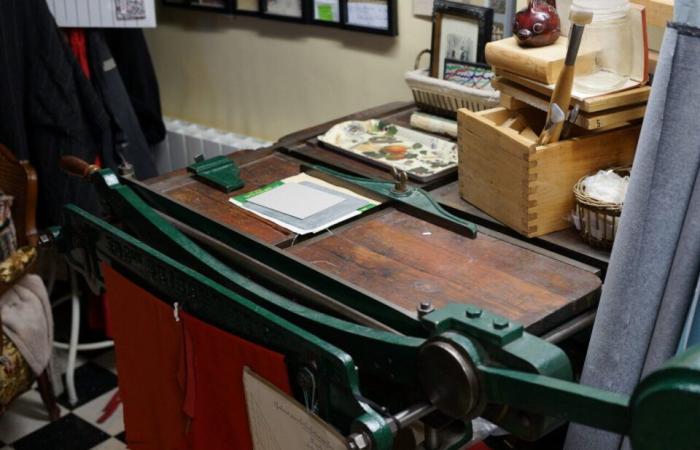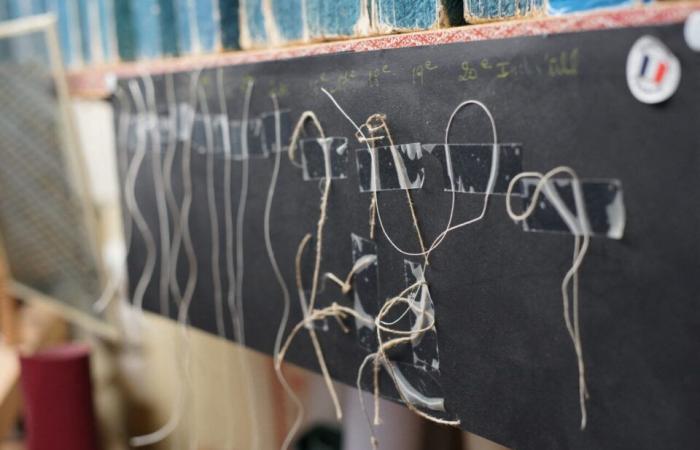Par
Nicolas Pelouas
Published on
6 oct. 2024 à 12h26
See my news
Follow The Courier – L’Écho
Near the Collegiate Church of Saint-Martin de Trôo (Loir-et-Cher), a small house does not look like much at first glance, but once inside, we discover a place “out of time”as Sandrine Salières Gangloff, the owner of the place, likes to describe it.
In her 24m² workshop, she practices the profession of book restorerand bookbinding machine.
A journey between Brittany and the capital
Before working and restoring works from all eras, the craftsman had an incredible journey to then work in the field.
Having grown up in the north of Brittany, in Perros-Guirec, she “always wanted to do an artistic career “, she confides. “I first wanted to be an archaeologist, and I stayed on the history of the arts, but around books.”
After studying visual arts with a Diploma in General University Studies (Deug), she met and did a first internship with a bookbinder, in the Breton town where she grew up. “It was a revelation at 27 “, she says.
While continuing to have food jobs, she is admitted to the Central Union of Decorative Arts (UCAD).
She obtained her CAP at the Nissim-de-Camondo Museum, near Parc Monceau in the 8th arrondissement of Paris.
She then began working in two workshops, while maintaining odd jobs on the side.
After 3 years, she returned to Côtes-d’Armor.
Supported by the Department, Sandrine Salières Gangloff finished her training by returning to the bookbinder who introduced her to the profession.
Arrival in the area
She first settled in Montoire-sur-le-Loir in 1996, before joining Trôo with the help of the mayor at the time: Christiane Morin via the Cœur de village scheme which allows an artisan to install more easily in a municipality.
“I work a little with local people, wealthy families,” explains Sandrine Salières Gangloff. But she doesn’t stop in the surrounding area or in France where most of her clients come from.
She also exchanges with people from Switzerland, Luxembourg and even Spain. “The history of books spans time and places,” says the bookbinder.
Throughout his career, some were skeptical of his activity.
« I have often been told to stop. It must be said that the competition is fierce. But I now have a solid base of clients,” she says.
“A duty of responsibility”
His job goes beyond the simple reconstruction of works.
Sandrine Salières Gangloff says: “It’s not just art, there is also a heritage value.
Until the 1990s, the profession was underestimated. There was a lack of control, and therefore a lot of losses in the books. There were in particular chemical elements which could degrade.”
With the transition to the new millennium, consciousness will evolve.
From now on, part of the job of restorer of works is “ to anticipate damage “, she warns. “You have to be careful with handling, when the place is too dry or too humid, with insects and with light.”
In terms of resources, they have been reviewed to minimally alter the paper, as with glues which are of natural origin, and not animal.
“The profession has become very scientific », points out the bookbinder.
« On a a duty of responsibility on the works that pass through our hands”, recalls the original Breton.
The profession relies heavily on the trust placed in it by its clients.
If institutions contact her, it is for two objectives: an exhibition, or to promote a fund.
However, these organizations require standards that the craftsman does not want to meet.
“Institutions operate with public offering markets. You have to advance the money to be paid much later. I can’t afford it,” she explains.
For her part, she remains “on a very traditional methodwhich dates from the 18the century “.
And that’s why many of her clients come to see her with their works to restore.
A sector on the verge of extinction
Sandrine Salières Gangloff is categorical about the situation of her profession: “It’s a profession where we disappear into total silence. There are many amateur clubs, but there is no longer enough work to make a living from them.”
The uses and the relationship with the book have changed: “The materiality of the book is different today,” she explains.
There remain “three or four semi-industrial workshops today in France. They are not profitable, but they compensate with their industrial activity.”
Around her to support her, book professions such as gilders or trimmers are becoming increasingly rare.

The fault lies with a sector which is struggling to survive.
“Until 2007, I pretty much earned my living,” explains the bookbinder.
Today, despite everything, she manages “to find balance ».
Today she is the last, to her knowledge, to do both preventive conservation and restoration.
“I have to be the only one in workshops like mine,” she laments. “There is a showcase on the Internet, but there must be around fifteen of us. When I started, there were 6,000 bookbinders. I experience the fall from within ».
An up-to-date archaeologist
With almost 30 years of experiencethe restorer assures that she can save “any book”.
But her job is divided into two parts: 80% of her time she spends in analysiswithout being assured of being paid for their expertise.
The remaining 20% is devoted to restauration pure.
“We have difficulty getting paid. We have a lot of constraints and sometimes we forget prevention,” warns Sandrine Salières Gangloff. Because once the work is returned to the client, the latter must continue to preserve his good.
The clients who come to see her are bibliophiles, true enthusiasts of old books who wish to restore books that are often rare or unusual, and to which they may have an emotional attachment.
“It’s sometimes irrational. It’s a discreet environment, but also very competitive,” she confides.
We must also pay attention to the origin of the books, there is a control work.
“You always have to be sure of the provenance of the work,” she explains, because it is not never safe from surprises.
A frame that is falling apart
Sandrine Salières Gangloff has security in her profession, by being a member of the National Trade Union of Gilding Brochure Binding (RBD), today attached to the National Union of Printing and Communication Industries (Uniic).
A restoration does not happen naturally, it is necessary “ make choices. It’s stressful, you never know if you’ll like it. It has to be worthy of what the customer expects,” she says.

The restorer respects the treaty of Cesare Brandi of 1963, which defined the rules of restoration in the art.
« We don’t invent “, she quotes before adding: “We don’t just repair, there is an investigation side, with the elements that the books provide.”
Workshops and open days
Sandrine Salières Gangloff can organize workshopsbut she warns: “It takes at least 10 courses to make a book”, the time to do all the placementthat is to say carry out all the actions to restore a book.
“There is a whole vocabulary » in his field.
At 58, she looks towards the future calmly: “I still have 10 years to work. But it’s a job you can’t stop.”
You will have to wait until the next European Craft Days for those who wish to take a look at his Trôo workshop, from Friday April 4 to Sunday April 6, 2025.
Follow all the news from your favorite cities and media by subscribing to Mon Actu.









